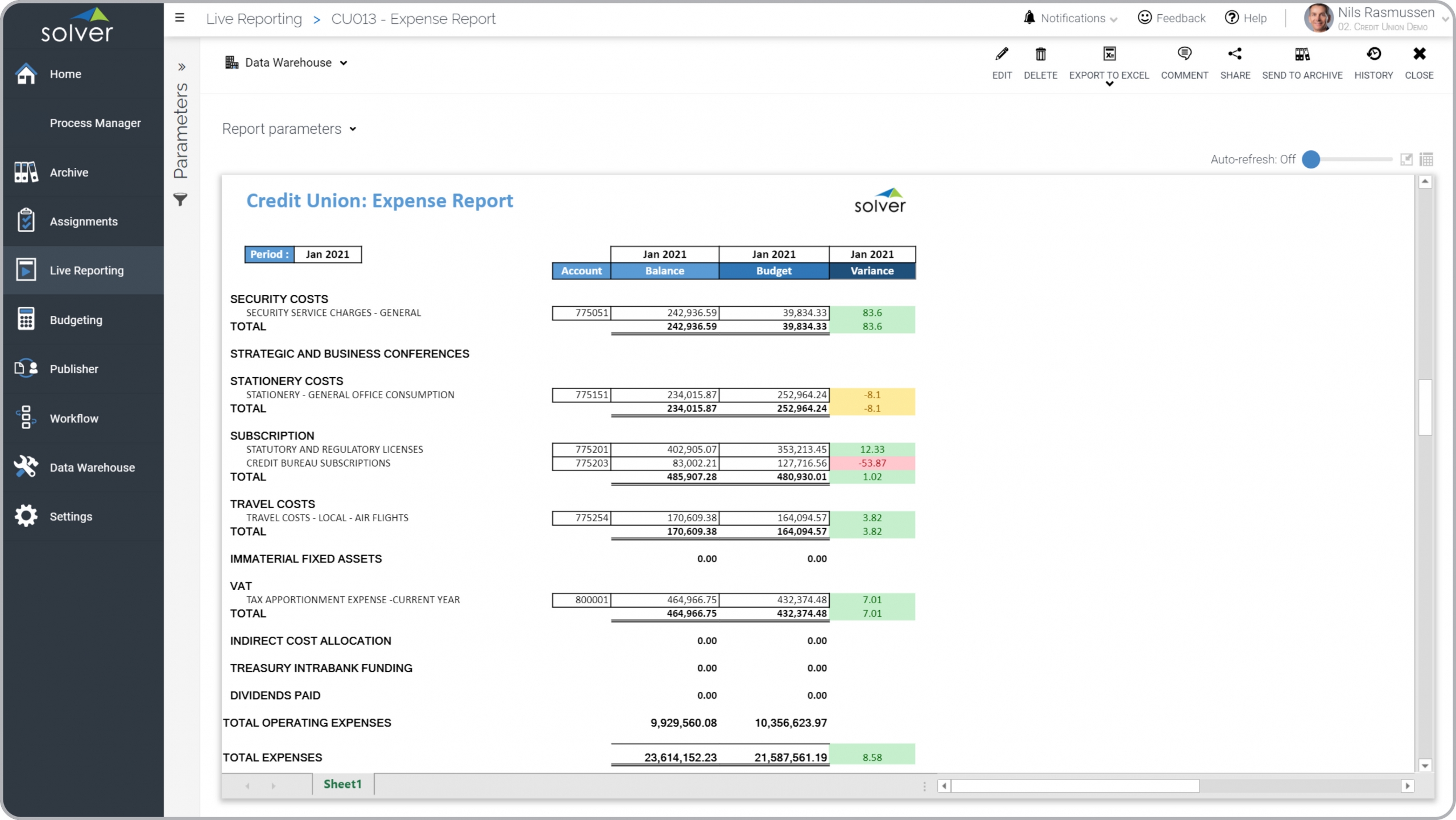Expense Variance Report for Credit Unions
What is
an
Expense Variance Report for Credit Unions
? Expense Variance Reports are considered financial control reports and are used by accountants and department managers to monitor actual expenditures compared to the budget. Some of the main functionality in this type of control report is that it dynamically expands expense accounts down the rows and summarize them to sub-totals and a grand total. The three columns show: 1) Actual expenses for the month, 2) Budget, and 3) Variance in percent. You find an example of this type of control report below.
Purpose of
Expense Variance Reports Credit Unions use Expense Variance Reports to give managers an easy way to monitor their department's expenses and to catch major budget variances. When used as part of good business practices in Accounting Departments, a company can improve its cost control and related decisions, and it can reduce the chances of major budget overruns occurring.
Example of an
Expense Variance Report Here is an example of an Expense Variance Report with actual and budget figures as well as actual to budget comparisons. [caption id="" align="alignnone" width="2560"]
 Example of an Expense Variance Report for Credit Unions[/caption] You can find hundreds of additional examples
here
Who Uses This Type of
Control report
? The typical users of this type of control report are: CFOs, Analysts, Controllers, Cost Accountants, Department Managers.
Other Reports Often Used in Conjunction with
Expense Variance Reports Progressive Accounting departments sometimes use several different Expense Variance Reports, along with profit & loss reports, balance sheets, cash flow statements, KPI reports, expense dashboards, budget models, forecasts and other management and control tools.
Where Does the Data for Analysis Originate From? The Actual (historical transactions) data typically comes from enterprise resource planning (ERP) systems like: Microsoft Dynamics 365 (D365) Finance, Microsoft Dynamics 365 Business Central (D365 BC), Microsoft Dynamics AX, Microsoft Dynamics NAV, Microsoft Dynamics GP, Microsoft Dynamics SL, Sage Intacct, Sage 100, Sage 300, Sage 500, Sage X3, SAP Business One, SAP ByDesign, Acumatica, Netsuite and others. In analyses where budgets or forecasts are used, the planning data most often originates from in-house Excel spreadsheet models or from professional corporate performance management (CPM/EPM) solutions.
What Tools are Typically used for Reporting, Planning and Dashboards? Examples of business software used with the data and ERPs mentioned above are:
Example of an Expense Variance Report for Credit Unions[/caption] You can find hundreds of additional examples
here
Who Uses This Type of
Control report
? The typical users of this type of control report are: CFOs, Analysts, Controllers, Cost Accountants, Department Managers.
Other Reports Often Used in Conjunction with
Expense Variance Reports Progressive Accounting departments sometimes use several different Expense Variance Reports, along with profit & loss reports, balance sheets, cash flow statements, KPI reports, expense dashboards, budget models, forecasts and other management and control tools.
Where Does the Data for Analysis Originate From? The Actual (historical transactions) data typically comes from enterprise resource planning (ERP) systems like: Microsoft Dynamics 365 (D365) Finance, Microsoft Dynamics 365 Business Central (D365 BC), Microsoft Dynamics AX, Microsoft Dynamics NAV, Microsoft Dynamics GP, Microsoft Dynamics SL, Sage Intacct, Sage 100, Sage 300, Sage 500, Sage X3, SAP Business One, SAP ByDesign, Acumatica, Netsuite and others. In analyses where budgets or forecasts are used, the planning data most often originates from in-house Excel spreadsheet models or from professional corporate performance management (CPM/EPM) solutions.
What Tools are Typically used for Reporting, Planning and Dashboards? Examples of business software used with the data and ERPs mentioned above are:
- Native ERP report writers and query tools
- Spreadsheets (for example Microsoft Excel)
- Corporate Performance Management (CPM) tools (for example Solver)
- Dashboards (for example Microsoft Power BI and Tableau)
Corporate Performance Management (CPM) Cloud Solutions and More Examples
August 22, 2021
TAGS:
Reporting,
Solver,
report writer,
Microsoft,
template,
practice,
Acumatica,
financial statement,
Netsuite,
Finance,
credit union,
planning,
GP,
fintech,
Business Central,
excel,
ax,
budget variance,
forecast,
Budget,
Dynamics 365,
budgeting,
bank,
Cloud,
Software,
Tableau,
SAP,
example,
best,
Sage,
BC,
D365,
NAV,
Intacct,
monthly,
expense analysis,
financial institution,
CPM,
report,
branch,
SL,
Management,
dynamics,
Power BI,
expense variance report

